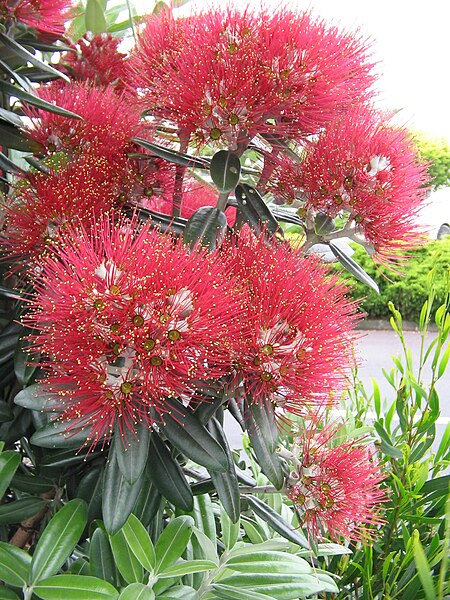 |
| Pōhutukawa flowers |
In the first story, Hutu and Kawa go on a canoe trip, advised by the friendly Grandpa Kiwi, meeting en route various birds and other plant fairies. It's full of attention to detail; with help from the nocturnal Grandpa Kiwi, they carve their canoe in the authentic manner, hollowing a totara twig with great time and labour using greenstone chisels, and smoothing it with mussel shells; the birds make them feather cloaks; and they encounter "Mr Kiwi" incubating an egg (as the male kiwi does with most species). The bird illustrations are very accurate; Avis Acres also wrote nature study guides.
 The two sequels take an ecological/conservationist turn. In Hutu and Kawa Meet Tuatara, the two Pohutukawa Babies help a sad and lonely tuatara find a new home, throwing him a hundredth birthday party; and in Hutu and Kawa find an island, they sail to an island (again using authentic Maori boatbuilding techniques) and help its inhabitants (which, correctly, include a different species of Pohutukawa fairies) get rid of a greedy and selfish possum (a storyline reflecting the depredation to indigenous wildlife caused by the introduction of the Common Brushtail Possum from Australia in the 19th century).
The two sequels take an ecological/conservationist turn. In Hutu and Kawa Meet Tuatara, the two Pohutukawa Babies help a sad and lonely tuatara find a new home, throwing him a hundredth birthday party; and in Hutu and Kawa find an island, they sail to an island (again using authentic Maori boatbuilding techniques) and help its inhabitants (which, correctly, include a different species of Pohutukawa fairies) get rid of a greedy and selfish possum (a storyline reflecting the depredation to indigenous wildlife caused by the introduction of the Common Brushtail Possum from Australia in the 19th century).It's a pleasant and interesting take on New Zealand wildlife, and I can see why these books were bestsellers. But it seems they went out of vogue.
Her first three books sold extremely well, but sales of the fourth were disappointing. Although children loved the fairies, sections of the education and publishing worlds were ambivalent toward the mixture of fantastical narrative with accurate illustrations and information. Reeds decided against publishing further stories and her work was subsequently turned down by other publishers. However, in 1990 Heinemann Reed republished the Hutu and Kawa books.
- Acres, Thyra Avis Mary, Dictionary of New Zealand Biography
 |
| "We must be cousins" - Hutu and Kawa meet a related species |
In a period before it was pointed out by writers such as Patricia Wrightson (1979) that folklore and fantasy needs to spring from 'place' ... European fairies have always found an uneasy home in Australia ...
- page 568, Images of Australia: a history of Australian children's literature, 1941-1970, Henry Maurice Saxby, 2002
... and applies equally to New Zealand.
Nevertheless, they're still admirable and clever works; it must have been a great pleasure to Avis Acres, at 80, to see them return to print after half a century.
- Ray


No comments:
Post a Comment